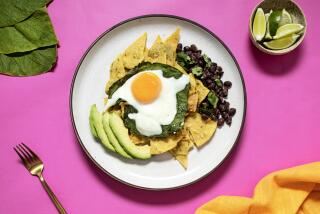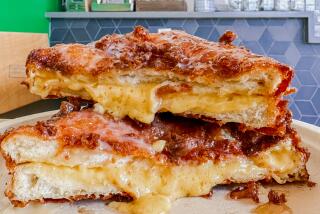In Praise of a Simple Food That Helps the World Keep Its Sunny Side Up
The “Cambridge World History of Food” says eggs are popular everywhere, but to know that, you don’t have to crack open that weighty tome. All you have to do is eat breakfast.
In my travels, I’ve had Scotch eggs, which are hard-boiled, coated with sausage and deep-fried; eggs with cold cuts and cheese at breakfast buffets in Scandinavia; huevos rancheros; raw eggs on Japanese rice; frothy French omelets; frittata-like egg tortillas filled with potatoes and served at room temperature in Spanish tapas bars; dehydrated eggs while backpacking in the wild; and--perhaps my favorite--fried egg sandwiches on cottony soft kaiser rolls from New York delis.
In Beijing some years ago, I came across a man cooking eggs on an upended metal barrel. Travelers must be careful about eating at street stalls, of course, but I couldn’t help myself. I was rewarded with one of the finest egg sandwiches west of the Hudson River, and I suffered no ill effects.
I admire eggs. They teach travelers about packing in one container, with no loose ends hanging out. They are inexpensive, rich in protein and readily available. Even at a fancy resort or on a cruise ship known for magnificent breakfast spreads, I go straight for the eggs.
“The egg is a great food for travelers, low in calories, high in protein, with vitamins and minerals,” says Joan Carter, a chef and registered dietitian at Baylor College of Medicine in Houston. One large egg has 74 calories, 6 grams of protein and 5 grams of fat, Carter says. (By contrast, a Sara Lee croissant packs 170 calories, 4 grams of protein and 8 grams of fat.)
Fried and scrambled eggs are butter sponges and can be far fattier than poached or boiled ones. Eggs also can be problematic for people with elevated cholesterol, which is associated with heart disease. A large egg has 212 milligrams of cholesterol; the American Heart Assn. advises a daily intake of no more than 300 milligrams. Eggs can contain salmonella, which causes food poisoning.
But there’s more to praise in eggs than to shatter. Above all, I love finding the egg in some of the most outlandish places and seeing how differently it is prepared and served. The egg is global but no instrument of globalization.
There’s an important distinction between seeing eggs and eating them. I am a moderately adventurous eater, but in China I couldn’t be forced to take even a bite of a so-called 100-year-old egg, which is buried, uncooked, in clay, saltpeter and tea leaves for several months. When it is unearthed, the shell has gone black and the inside is gelatinous and green-veined.
Living in Tokyo for several years taught my sister to enjoy raw egg and rice bowl breakfasts, with which she favors seaweed. I was just a teenager when my parents and I visited her and valiantly tried to follow her example. Finally, at a ryokan in Kyoto, she arranged for my father to have cooked eggs for breakfast. I will never forget the look on his face when he put his chopsticks to his mouth and realized that the morsel of artfully presented omelet he was about to eat was stone cold.
It’s hard for me to even think about eating a boiled duck egg with a partly formed chick inside, a favored street food in the Philippines, known as balut, and in Vietnam, called hot vit lon. I asked Richard Sterling, who has written about the cuisines of Spain, Hong Kong and Vietnam, among others, for Lonely Planet’s World Food guidebook series, what this Southeast Asian egg specialty tastes like. “It’s delicious,” he says, “vaguely like French cassoulet.”
Sterling got his unflappable taste buds and cast-iron stomach eating powdered egg C rations in the Vietnam War. He has even tried ant eggs, atop a steak, in Tijuana; he claims they are wonderfully crunchy. These days, at home in the Bay Area, he relishes Sunday brunches at San Francisco restaurants where caviar omelets are served. “Eggs with eggs,” he says gleefully.
I can do without fish eggs, but I fondly remember many of my favorites laid by hens, the mode of preparation, the cooks and the places where I ate them. On a bicycling trip in County Clare, Ireland, six years ago, the breakfasts were gigantic servings of porridge, bacon, eggs and brown bread, served by pithy Irish farm women who could make the newspaper sound like the poetry of Yeats.
Later, on a clattering local train bound from New York City to the Jersey shore, I had an egg salad sandwich on white bread, which I had prepared at home and packed in a wicker basket. I can’t say why, but I firmly believe that egg salad and train rides are soul mates, like hot dogs and baseball games.
I was once lucky enough to eat eggs at La Mere Poulard on Mont Saint-Michel in France. I had been on a 30-mile walking vacation in Brittany, ending at the island abbey, connected to the mainland by a long causeway. To celebrate my accomplishment, I ordered the $22 set menu, its centerpiece a plain, unbelievably light omelet that tasted of wood smoke and the Middle Ages. Merveilleux.
No one is sure where chickens and their highly palatable eggs came from. The question bears further study and a lot more travel, I believe. Along the way, maybe I’ll figure out which came first.
More to Read
Sign up for The Wild
We’ll help you find the best places to hike, bike and run, as well as the perfect silent spots for meditation and yoga.
You may occasionally receive promotional content from the Los Angeles Times.






